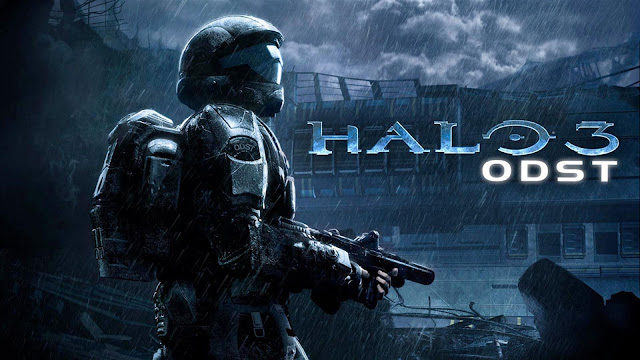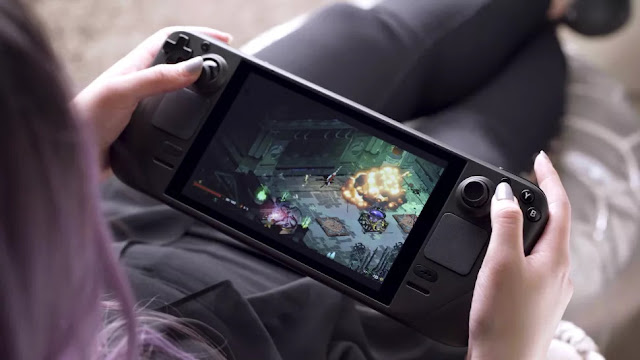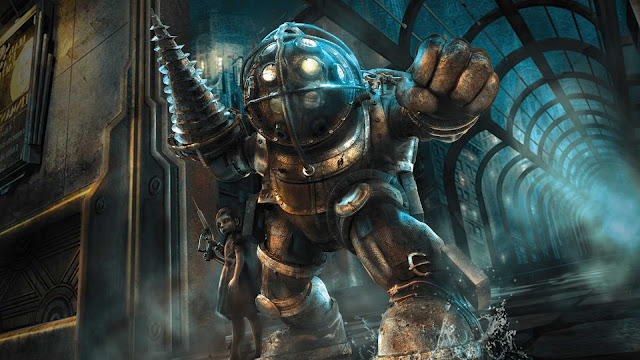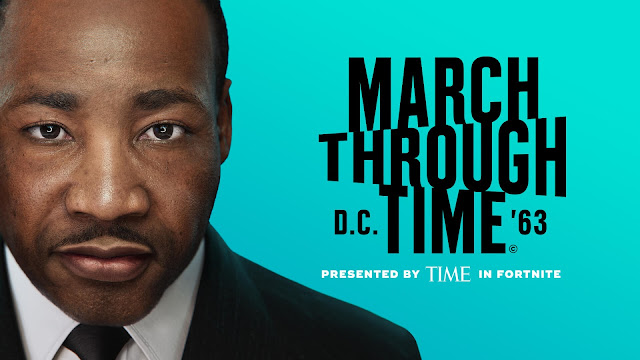Lead to Halo on PC: Halo 3: ODST Review
Remember when I said Halo Wars fails as a Halo campaign due to it's terrible story and characters? Well in that same year the opposite happened when Bungie released, of all things, an expansion pack for Halo 3, Halo 3: ODST. Taking the conflict to a smaller scale and focusing on a less powerful protagonist, Halo 3: ODST takes the series in a different direction than usual. But is it a good one, and is it still worth making it through to see the dawn?
ODST takes place at the same time as Halo 2's first three missions and focuses on a squad of Orbital Drop Shock Troopers, an elite special forces unit that strap themselves into pods and are shot at the surface. Th focus is namely on a squad of ODST's who are part of a mission to aid the Master Chief during the events of 2. You've got Buck, the wiseass leader who just wants to get his troops through the next mission alive; Dutch, the heavy weapons specialist best described as a simple man making his way through the universe; Mickey, an explosives specialist who's a bit on the green side; Romeo, a sniper with a mouth quicker than his brain and a self professed ladies man; and finally the Rookie, the latest member of the squad who doesn't talk at all and has no personality. Guess which one you play as?
Well either way this squad is joined their mission by intelligence officer Captain Veronica Dare, with who Buck had a past relationship with. Dare in turn hijacks the mission and pilots them away from the Covenant ship they were supposed to land on into the city of New Mombasa. However this is right when the Covenant leave and spark a giant explosion that doesn't destroy the city but does create an EMP field that kills all power and sends the squad plummeting to the ground and leaves the Rookie knocked out for six hours. Now it's up to an all alone Rookie to find what's left of his team, maybe discover what Dare was after, and escape New Mombasa before the Covenant turn it to glass.
 So as you can tell, this is a much different story, one with much smaller stakes. You're not trying to stop alien super weapons or take down eldritch abominations, you're just a dude with a gun trying to escape an alien infested city. You also don't have super armor with shielding to stop bullets that can be recharged, you have stamina, your health, and then you're fucked when that's gone. In order to gain health you have to get health packs and you don't punch as hard as you used to, so yeah, it's a much harder game than previous shooters, evoking more Halo 1 than anything, especially with dual wielding gone. Even three brutes will make you sweat and burn through ammo, forcing you to scavenge for guns regularly. And with the new Engineer race, Brute's can become even more powerful with additional shielding so it's even tougher and makes you burn through ammo even quicker.
So as you can tell, this is a much different story, one with much smaller stakes. You're not trying to stop alien super weapons or take down eldritch abominations, you're just a dude with a gun trying to escape an alien infested city. You also don't have super armor with shielding to stop bullets that can be recharged, you have stamina, your health, and then you're fucked when that's gone. In order to gain health you have to get health packs and you don't punch as hard as you used to, so yeah, it's a much harder game than previous shooters, evoking more Halo 1 than anything, especially with dual wielding gone. Even three brutes will make you sweat and burn through ammo, forcing you to scavenge for guns regularly. And with the new Engineer race, Brute's can become even more powerful with additional shielding so it's even tougher and makes you burn through ammo even quicker.
Speaking of, there aren't any new weapons in ODST but some previously existing weapons are changed. The Plasma Rifle is now Halo 2's Brute Plasma Rifle with it's red plasma and red coloring, but it's still the same shield destroying gun. The SMG now has a scope, silencer, and 12 less shots in it; it's meant to be more of a rifle but it's too weak for that so it gets swapped out pretty quick as you burn through ammo. Same is true for the pistol, which regains the scope and 12 rounds from Halo 1, but it's a silenced version of the Halo 2 pistol so it's not nearly as godly. Also the Battle Rifle is gone so the Covenant Carbine becomes your new best friend and savior.
This is most true in the games nighttime levels, which follow the Rookie with no real ammo or equipment except what he can gain. The entire nighttime portion is an open world where you explore the large city of New Mombasa, something new for the Halo series and what makes the game stand out. In your quest however you are assisted by the city's AI, the Superintendent, who will guide you to where you need to go. On top of this the Superintendent will guide you to another first in the series, audio logs, these logs tell what is called Sadie's Story. Following the story of a teenager trapped in Mombasa when the Covenant roll up as she discovers a mystery with ramifications for the Rookie's mission along with learning the truth of Mombasa's politics. It's an interesting story and one worth searching out, adding some post-game replay value and unlocking weapons caches the more you learn the story.
But finding the squad is the main focus, and when you find a hint to their locations you'll play a level with said squad member as their story occurred. This is traditional Halo gameplay and there's a lot of variety on hand, from negotiating Mombasa's rooftops to driving through a wildlife preserve, ODST's more traditional missions are true expansion's on 3 and I really like them. And that goes for the final night levels when the endgame begins, those are pretty fun and have some payoff for Sadie's Story as well. I mean there's not a whole lot to say about these missions, did you like 3? You'll like these.
But while the daytime levels are more like 3, ODST's nighttime levels are where it's identity shines. Neon lit skyscrapers accent purple covenant ships roaming the rain drenched drenched city, the urban sprawl turned warzone that still has burning wreckage from even the previous hour. It's perhaps the most artistically striking that a safe series like Halo has been, all accented by a wonderful score from series composer Marty O' Donnell who eschews his famous choir pieces for more jazzy and noir style with some rumbling action pieces that are also memorable. The only real porblem is the new VISR system whoch highlights enemies and makes things brighter at the cost of ruining this lovely aesthetic, I make it a point to only use VISR in combat as a result.
What makes playing ODST after Wars so interesting however is the casts and how different they are. Where the writing with Wars was painfully forgettable and the cast was boring as shit, ODST shines with it's mystery and memorable cast. The characters of ODST have a rapport that makes you want to see where their story went as you follow in their steps with their wit and retorts able to carry the relatively short campaign well. It's a massive step from Halo Wars' exposition dumps of characters with no real personality and one of the reasons I love ODST so much, even compared to mainline games in the series.
 Of course, this lead us to our final piece, multiplayer, which while it is packed in with Halo 3's multiplayer component, the real meat for ODST is Firefight. A co-op wave mode where you and up to three friends are given limited resources and told to hold out forever against the Covenant. Your progress is determined by sets, there are three rounds in a set in five waves in a round. You will die, but it's a matter of seeing how many you can take out with you and due to the weakness of the player's it's tough. And then the game starts turning on those fancy skulls from Halo 3 which suddenly means the enemy can be jacked as hell, or you need to punch enemies in the face to regenerate stamina. Unpredictable, chaotic, and desperate, Firefight is easily the breakout mode of ODST and is a great add-on to a great campaign.
Of course, this lead us to our final piece, multiplayer, which while it is packed in with Halo 3's multiplayer component, the real meat for ODST is Firefight. A co-op wave mode where you and up to three friends are given limited resources and told to hold out forever against the Covenant. Your progress is determined by sets, there are three rounds in a set in five waves in a round. You will die, but it's a matter of seeing how many you can take out with you and due to the weakness of the player's it's tough. And then the game starts turning on those fancy skulls from Halo 3 which suddenly means the enemy can be jacked as hell, or you need to punch enemies in the face to regenerate stamina. Unpredictable, chaotic, and desperate, Firefight is easily the breakout mode of ODST and is a great add-on to a great campaign.
Halo ODST is more Halo 3 but in a new direction, the stripping away of things and certainties you're used makes things more desperate and tense while the new atmosphere at night gives ODST a whole new identity that makes it stand out from other games. With a memorable cast and great story to round it out, it's easy to see why it's considered a cult classic in the series and one that deserves a lot more love than it gets. But Bungie wasn't done just yet, as we take another look into the past and remember... Reach.
ODST takes place at the same time as Halo 2's first three missions and focuses on a squad of Orbital Drop Shock Troopers, an elite special forces unit that strap themselves into pods and are shot at the surface. Th focus is namely on a squad of ODST's who are part of a mission to aid the Master Chief during the events of 2. You've got Buck, the wiseass leader who just wants to get his troops through the next mission alive; Dutch, the heavy weapons specialist best described as a simple man making his way through the universe; Mickey, an explosives specialist who's a bit on the green side; Romeo, a sniper with a mouth quicker than his brain and a self professed ladies man; and finally the Rookie, the latest member of the squad who doesn't talk at all and has no personality. Guess which one you play as?
Well either way this squad is joined their mission by intelligence officer Captain Veronica Dare, with who Buck had a past relationship with. Dare in turn hijacks the mission and pilots them away from the Covenant ship they were supposed to land on into the city of New Mombasa. However this is right when the Covenant leave and spark a giant explosion that doesn't destroy the city but does create an EMP field that kills all power and sends the squad plummeting to the ground and leaves the Rookie knocked out for six hours. Now it's up to an all alone Rookie to find what's left of his team, maybe discover what Dare was after, and escape New Mombasa before the Covenant turn it to glass.
 So as you can tell, this is a much different story, one with much smaller stakes. You're not trying to stop alien super weapons or take down eldritch abominations, you're just a dude with a gun trying to escape an alien infested city. You also don't have super armor with shielding to stop bullets that can be recharged, you have stamina, your health, and then you're fucked when that's gone. In order to gain health you have to get health packs and you don't punch as hard as you used to, so yeah, it's a much harder game than previous shooters, evoking more Halo 1 than anything, especially with dual wielding gone. Even three brutes will make you sweat and burn through ammo, forcing you to scavenge for guns regularly. And with the new Engineer race, Brute's can become even more powerful with additional shielding so it's even tougher and makes you burn through ammo even quicker.
So as you can tell, this is a much different story, one with much smaller stakes. You're not trying to stop alien super weapons or take down eldritch abominations, you're just a dude with a gun trying to escape an alien infested city. You also don't have super armor with shielding to stop bullets that can be recharged, you have stamina, your health, and then you're fucked when that's gone. In order to gain health you have to get health packs and you don't punch as hard as you used to, so yeah, it's a much harder game than previous shooters, evoking more Halo 1 than anything, especially with dual wielding gone. Even three brutes will make you sweat and burn through ammo, forcing you to scavenge for guns regularly. And with the new Engineer race, Brute's can become even more powerful with additional shielding so it's even tougher and makes you burn through ammo even quicker. Speaking of, there aren't any new weapons in ODST but some previously existing weapons are changed. The Plasma Rifle is now Halo 2's Brute Plasma Rifle with it's red plasma and red coloring, but it's still the same shield destroying gun. The SMG now has a scope, silencer, and 12 less shots in it; it's meant to be more of a rifle but it's too weak for that so it gets swapped out pretty quick as you burn through ammo. Same is true for the pistol, which regains the scope and 12 rounds from Halo 1, but it's a silenced version of the Halo 2 pistol so it's not nearly as godly. Also the Battle Rifle is gone so the Covenant Carbine becomes your new best friend and savior.
This is most true in the games nighttime levels, which follow the Rookie with no real ammo or equipment except what he can gain. The entire nighttime portion is an open world where you explore the large city of New Mombasa, something new for the Halo series and what makes the game stand out. In your quest however you are assisted by the city's AI, the Superintendent, who will guide you to where you need to go. On top of this the Superintendent will guide you to another first in the series, audio logs, these logs tell what is called Sadie's Story. Following the story of a teenager trapped in Mombasa when the Covenant roll up as she discovers a mystery with ramifications for the Rookie's mission along with learning the truth of Mombasa's politics. It's an interesting story and one worth searching out, adding some post-game replay value and unlocking weapons caches the more you learn the story.
But finding the squad is the main focus, and when you find a hint to their locations you'll play a level with said squad member as their story occurred. This is traditional Halo gameplay and there's a lot of variety on hand, from negotiating Mombasa's rooftops to driving through a wildlife preserve, ODST's more traditional missions are true expansion's on 3 and I really like them. And that goes for the final night levels when the endgame begins, those are pretty fun and have some payoff for Sadie's Story as well. I mean there's not a whole lot to say about these missions, did you like 3? You'll like these.
But while the daytime levels are more like 3, ODST's nighttime levels are where it's identity shines. Neon lit skyscrapers accent purple covenant ships roaming the rain drenched drenched city, the urban sprawl turned warzone that still has burning wreckage from even the previous hour. It's perhaps the most artistically striking that a safe series like Halo has been, all accented by a wonderful score from series composer Marty O' Donnell who eschews his famous choir pieces for more jazzy and noir style with some rumbling action pieces that are also memorable. The only real porblem is the new VISR system whoch highlights enemies and makes things brighter at the cost of ruining this lovely aesthetic, I make it a point to only use VISR in combat as a result.
What makes playing ODST after Wars so interesting however is the casts and how different they are. Where the writing with Wars was painfully forgettable and the cast was boring as shit, ODST shines with it's mystery and memorable cast. The characters of ODST have a rapport that makes you want to see where their story went as you follow in their steps with their wit and retorts able to carry the relatively short campaign well. It's a massive step from Halo Wars' exposition dumps of characters with no real personality and one of the reasons I love ODST so much, even compared to mainline games in the series.
 Of course, this lead us to our final piece, multiplayer, which while it is packed in with Halo 3's multiplayer component, the real meat for ODST is Firefight. A co-op wave mode where you and up to three friends are given limited resources and told to hold out forever against the Covenant. Your progress is determined by sets, there are three rounds in a set in five waves in a round. You will die, but it's a matter of seeing how many you can take out with you and due to the weakness of the player's it's tough. And then the game starts turning on those fancy skulls from Halo 3 which suddenly means the enemy can be jacked as hell, or you need to punch enemies in the face to regenerate stamina. Unpredictable, chaotic, and desperate, Firefight is easily the breakout mode of ODST and is a great add-on to a great campaign.
Of course, this lead us to our final piece, multiplayer, which while it is packed in with Halo 3's multiplayer component, the real meat for ODST is Firefight. A co-op wave mode where you and up to three friends are given limited resources and told to hold out forever against the Covenant. Your progress is determined by sets, there are three rounds in a set in five waves in a round. You will die, but it's a matter of seeing how many you can take out with you and due to the weakness of the player's it's tough. And then the game starts turning on those fancy skulls from Halo 3 which suddenly means the enemy can be jacked as hell, or you need to punch enemies in the face to regenerate stamina. Unpredictable, chaotic, and desperate, Firefight is easily the breakout mode of ODST and is a great add-on to a great campaign. Halo ODST is more Halo 3 but in a new direction, the stripping away of things and certainties you're used makes things more desperate and tense while the new atmosphere at night gives ODST a whole new identity that makes it stand out from other games. With a memorable cast and great story to round it out, it's easy to see why it's considered a cult classic in the series and one that deserves a lot more love than it gets. But Bungie wasn't done just yet, as we take another look into the past and remember... Reach.












Comments
Post a Comment